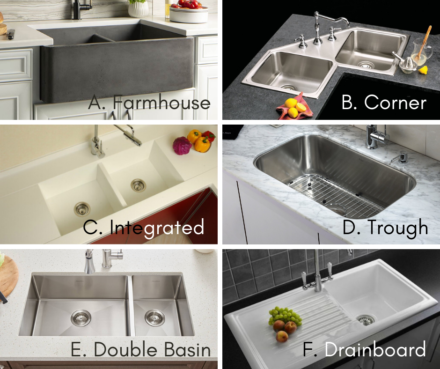
Like with any DIY project, there are varying levels of difficulty. Regarding sinks, the process is definitely one for a more seasoned DIY-er, and the level of complexity climbs rather quickly from “I can do this” to “maybe I should have hired someone to do this…” Today, we are going to looks at different types of kitchen sinks and list them from their ranging level of difficulty.
Drop-in, undermount, or apron sinks all come in a variety of materials, including cast iron, stainless steel, granite composite, to fireclay composite. (Here is a great article listing all of the different types of kitchen sinks.) Their style, whether it a single or a double basin, should coincide with your own as well as with yours and your family’s needs. For example, in regards to aesthetics, stainless steel or granite composite sinks have a more modern feel opposed to fireclay or cast iron, which can be more timeless. In terms of function, single basin sinks are great for large families and for cleaning larger items, such as pots and pans; whereas double basin sinks are more multiple purpose as they have separate spaces for cleaning and then rinsing and drying.
Whatever your style and whatever your need, swapping out your kitchen sink can have a significant impact on your kitchen’s functionality and look. If you plan on tackling the project, here is some insight into the process as well as what to expect in terms of difficulty.
LESS DIFFICULT
Top Mount/Drop-In Sink. If you are looking to change your existing kitchen sink without too much hassle, the easiest (and most common) choice would be a top mount or drop-in sink. For a brief overview of the process, check out the video below.
MEDIUM DIFFICULTY
Undermount Sink. Installing an undermount sink can be more difficult than a drop-in. It will also require you to enlist a friend or family member for help. To learn more, see the listed video.
MOST DIFFICULT
Apron/Farmhouse Sink. The apron sink is one that extends over the ridge of your countertops. It is for this same reason, that this type of project is mostly suited to a well-seasoned DIY-er.
Unless you are merely swapping out an old apron sink for another (which is unlikely), this project will require you to cut into your current cupboards and countertops in order to properly install it. The video below can take you through the installation process.
Whatever direction you choose for your project, these videos are merely a starting point for proper preparation. As with most projects, unless you are a professional, the process can be far more extensive and time-consuming than the videos included imply. As a result, do your research, plan ahead, create a strategy, and then execute. Take pictures along the way of the plumbing, just in case your plan goes awry, and then be willing to ask for help if you need it. Let us know if you have recently completed this project for any additional pointers, and good luck on swapping out your kitchen sink!
